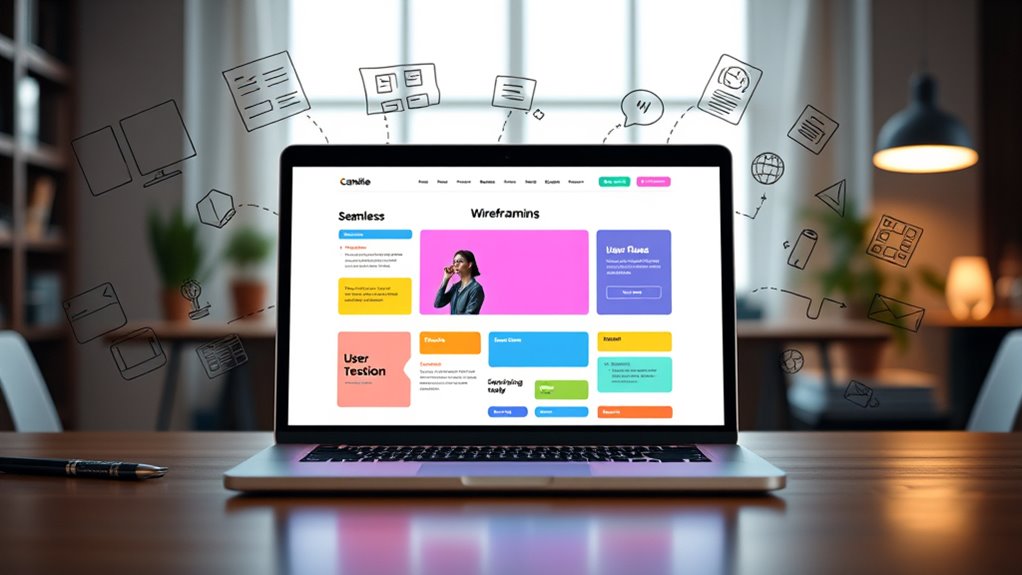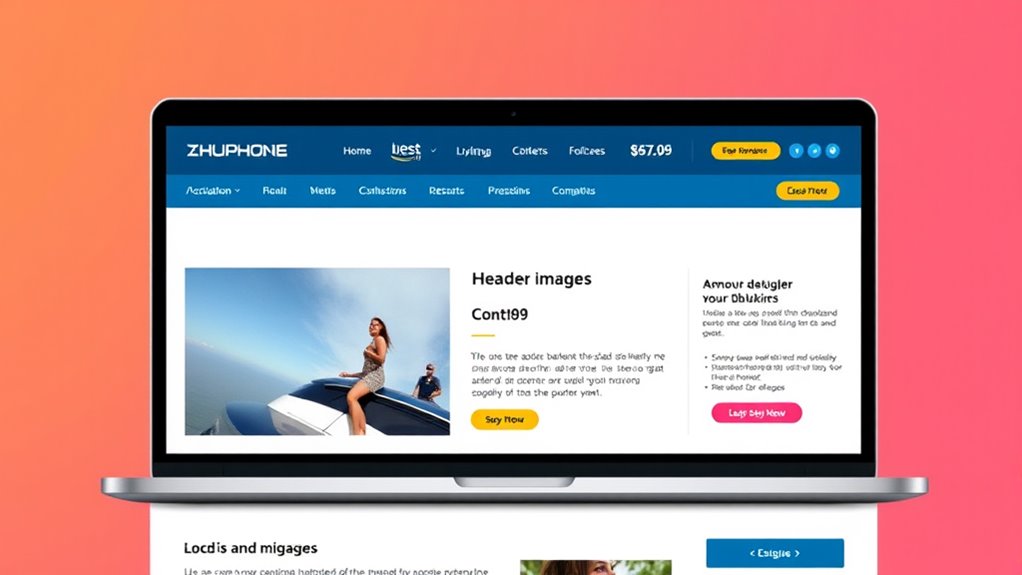To improve your rankings without building links, focus on enhancing your website’s user experience. Speed up your site by optimizing images, minimizing code, and leveraging browser caching. Make navigation clear and intuitive, guaranteeing visitors can easily find content. Confirm your site is mobile-friendly with a responsive design. Use better content layout, including headings and visuals, to boost readability. Adding user engagement features like reviews or live chat can increase time on your site—keep exploring these strategies to see how they work for you.
Key Takeaways
- Optimize site speed by compressing images, leveraging caching, and minimizing code to improve user experience and search rankings.
- Enhance website navigation with clear menus and logical structure for easier content discovery and better crawlability.
- Implement responsive design to ensure mobile-friendly layouts, reducing bounce rates and aligning with Google’s mobile-first indexing.
- Improve content readability using headings, bullet points, and visuals to increase engagement and time on site.
- Add user engagement features like live chat and reviews to boost interaction, trust, and signal content value to search engines.

Have you ever wondered if you can boost your search rankings without the hassle of building links? The good news is, you absolutely can. One of the most effective ways to improve your rankings is by optimizing your website’s user experience (UX). Search engines prioritize websites that deliver value to visitors, and a seamless, engaging UX can profoundly impact your rankings without the need for external link-building efforts.
Start by focusing on your site’s speed. Slow-loading pages frustrate users and cause them to bounce quickly, which signals to search engines that your site isn’t providing a good user experience. Use tools like Google PageSpeed Insights to identify and fix issues that slow down your site. Compress images, leverage browser caching, and minimize code to guarantee your pages load swiftly across all devices. When visitors enjoy a fast experience, engagement metrics improve, and search engines interpret that as a sign of quality.
Prioritize site speed by optimizing images, caching, and code for better user experience and higher search rankings.
Next, pay attention to your website’s navigation. A clear, intuitive menu helps visitors find what they’re looking for without frustration. Use logical categories, include a search bar, and ensure important pages are easily accessible from the homepage. When users can quickly discover relevant content, they stay longer and interact more, sending positive signals to search engines. Additionally, a well-structured site hierarchy improves crawlability, making it easier for search engines to understand your content.
Another vital aspect is mobile optimization. With more users browsing on smartphones and tablets, a mobile-friendly design isn’t optional — it’s fundamental. Responsive layouts that adapt to different screen sizes provide a consistent experience, reducing bounce rates and increasing time on site. Google’s mobile-first indexing means your mobile site’s performance directly impacts your rankings. Test your website on various devices to ensure usability remains high, and fix issues like overlapping elements, tiny fonts, or unclickable buttons.
Content layout and readability also play an important role. Break up long blocks of text with headings, bullet points, and visuals. Clear, concise language keeps visitors engaged and encourages them to explore further. When users find your content easy to read and navigate, they’re more likely to share it, spend more time on your site, and return later — all factors that positively influence your rankings.
Finally, consider user engagement features like live chat, reviews, or personalized recommendations. These elements foster trust and keep visitors interacting with your site longer. When search engines see increased engagement and lower bounce rates, they interpret your site as valuable and relevant, which can boost your rankings naturally. Improving UX isn’t just about aesthetics; it’s a strategic move that aligns with what search engines prioritize, helping you move up in search results without the need for building external links.
Frequently Asked Questions
How Quickly Can UX Changes Impact Search Rankings?
UX changes can impact your search rankings within days to weeks, depending on the modification’s significance. If you implement a major site speed improvement or simplify navigation, search engines may notice quickly and adjust rankings accordingly. Smaller tweaks might take longer to influence rankings as search engines crawl and reassess your site over time. Consistent, user-focused UX improvements tend to produce more noticeable and lasting ranking benefits.
Are Certain Types of UX Improvements More Effective Than Others?
Yes, some UX improvements are more effective than others. Focus on enhancing page load speed, simplifying navigation, and improving mobile responsiveness. These changes help users find what they need faster, reduce bounce rates, and boost engagement. Clear calls-to-action and intuitive layouts also improve user experience, encouraging longer visits. Prioritize these areas, and you’ll see quicker, more significant impacts on your search rankings without needing to build links.
Do UX Changes Affect Bounce Rates and Engagement Metrics?
Yes, UX changes can profoundly affect bounce rates and engagement metrics. When you improve site speed, navigation, or content readability, users tend to stay longer and interact more. Clear calls-to-action and a seamless experience reduce frustration, encouraging deeper engagement. By making your website easier to use and more appealing, you naturally decrease bounce rates and boost metrics like time on site and conversions.
Can UX Optimizations Replace the Need for Backlink Building?
Think of UX optimizations as your digital Swiss Army knife—they can markedly boost your rankings without relying solely on backlinks. While they improve user satisfaction, engagement, and conversions, they don’t fully replace the power of quality backlinks. Instead, combine UX enhancements with strategic link-building for the best results. So, no, UX alone can’t completely replace backlinks, but it definitely sets a strong foundation for sustainable growth and better search visibility.
How Do Search Engines Interpret UX Signals in Ranking Algorithms?
Search engines interpret UX signals like bounce rates, time on site, and page load speed to assess user satisfaction. When your site offers a seamless, engaging experience, it signals quality and relevance, boosting your rankings. You should focus on optimizing navigation, reducing load times, and providing valuable content. These improvements help search engines understand that users find your site useful, which can positively influence your rankings without needing to build links.
Conclusion
Remember, Rome wasn’t built in a day, and your SEO gains won’t happen overnight either. By focusing on user experience, you can move your rankings without the need for endless link-building. Make your site intuitive, fast, and engaging, and search engines will notice. Keep refining your UX, stay patient, and trust that steady improvements will pay off in the long run. After all, slow and steady wins the race.









